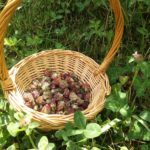Stinging nettle is a hardy perennial native to Europe, Asia, northern Africa and western North America. It spreads by both seed and rhizomes, which means it's fairly invasive given the opportunity. It prefers moist rich soil in partial shade, but if there's enough moisture, it will grow in full sun as well. Larger animals tend to avoid it due to ...

